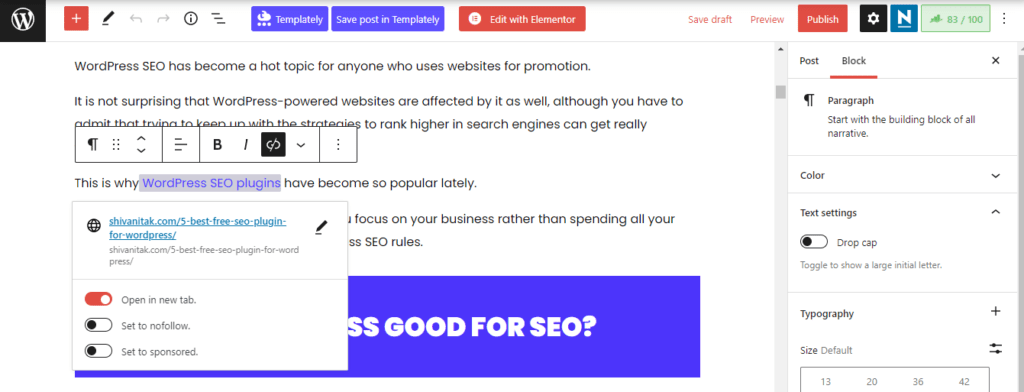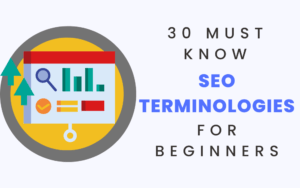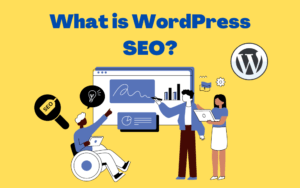WordPress SEO can be a little daunting I know.
That’s why I’ve decided to share my 10 WordPress SEO tips with you.
Do you have a WordPress blog?
If so, you know that WordPress is the most used CMS in the world.
In fact, it powers over 32% of all websites on the internet.
That’s a lot of websites!
One reason for this is because it’s free to use.
The other reason is that it’s incredibly easy to use and has an excellent user interface.
WordPress is a great tool for creating web pages but it can easily be turned into a lousy tool by the way you use it.
While the theme and basic formatting are easy to set up and customize, other tasks are not so simple, especially if you want to make sure that search engines such as Google and Bing pick up on your site content so your page hits the top level of the search results pages.
As a blog owner and writer, I’ve always been interested in keywords, SEO, and all things Google.
WordPress SEO doesn’t have to be a pain in the neck for you.
In fact, creating helpful WordPress SEO tips will only help your website rank higher on Google, and attract more traffic from all over the world.
What Is WordPress SEO?
We all know that WordPress is a highly customizable CMS that allows us to have great control over our website’s features.
However, with all these features, WordPress also comes with its own SEO options that allow you to boost your website’s ranking.
WordPress SEO has become a hot topic for anyone who uses websites for promotion.
It is not surprising that WordPress-powered websites are affected by it as well, although you have to admit that trying to keep up with the strategies to rank higher in search engines can get really tiresome.
This is why WordPress SEO plugins have become so popular lately.
They are meant to help you out by letting you focus on your business rather than spending all your time tweaking settings and learning WordPress SEO rules.
Is WordPress good for SEO?

WordPress is a great CMS that you can use for SEO.
There are many benefits of using WordPress for your SEO needs but it does have its limitations.
You need to make sure that you set up the right plugins.
You will also need to understand the WordPress SEO principles on how to make sure your site is optimized for users and Google web crawlers.
There’s no denying that WordPress is the most popular Content Management System in the world (CMS).
Many of its features make it great for SEO and help you rank higher on Google.
However, not many people use these features.
It’s one of the most used CMS systems on the web, with over 75 million websites running on it.
There are more WordPress themes and plugins than you can count on your fingers.
These incredible numbers prove that WordPress is here to stay — even with other competitors rising to compete.
It’s used by everyone from small businesses to Fortune 500 companies and top bloggers who get millions of visitors each month.
If you haven’t had a look at the stats lately, then it’s time you did.
You’ll see that 40+% of all websites on the internet are powered by WordPress, to be exact, it’s now making up 54.4% of the market!
Now, if you have already gotten your head around WordPress and have it up and running for your business or blog, but still believe it’s only for non-profit websites or blogs, then it’s time for you to truly get to know this amazing Content Management System / CMS that powers millions of websites worldwide.
10 WordPress SEO Tips
WordPress SEO can be confusing.
People often ask me what are the best WordPress SEO plugins, how to get more traffic from Google, or even if their WordPress SEO is working.
I’ve spent a lot of time searching for the best WordPress SEO tips and have tested these tips myself.
They may not all be super-advanced but they should help you to improve your website ranking and overall positioning in the search engines.
WordPress SEO (Search Engine Optimization) is one of the most important things.
For that, you need to do a lot of work, like comment on other blogs, use some specific plugins, and much more.
I have a good experience with WordPress SEO, so today I’m going to share the 10 most important tips for WordPress SEO.
I hope it will help you to get a better ranking at Search Engines.
Image Optimization
It might sound like a weird thing to say, but how your images are optimized can actually have an impact on your WordPress SEO.
Images are often used in SERPs as part of the Knowledge Graph.
This is extra information Google serves at the top of your search results.
Most people rely on this info because it’s right there in the search results and provides answers to questions they’re looking for.
Images are one of the most important factors in user experience.
If a UX designer fails to create a user-friendly website – the visitor will leave. If a content creator fails to create appealing and attention-grabbing content, no one will read it.
And even if your product or service is amazing – without images you can’t show it to the world.
Today, I want to share with you three ways that your images can help improve your SEO:
1. Optimizing image alt text
Improving your website ranking is not as easy as many people think.
There are lots of different factors that impact your search engine ranking.
One of them is the alt text of your images.
So let’s talk about optimizing the image’s alt text.
ALT attributes play a vital role in SEO.
The image alt text is one of the most important factors in an image tag.
The Image alt text tells search engine crawlers, what kind of images are in your blog post; whether it is on the page or off the page, and helps us to get a little bit better ranking.
Do you know what an alt tag is?
Alt-text is the text that appears when your image cannot be loaded.
If you have an image with your logo, for example, and someone does not have an internet connection, then this person will see the alt text.
The alt text should be written in such a way that people using screen readers can understand what the image displays.
2. Optimizing image file names
Images make the page look fantastic.
They capture the moment, give a peek into what’s to come, and help make a website stand out.
However, we sometimes forget to optimize them to do everything they can do
What a difference one file name can make!
Changing the name of an image can have an impact on your Google rankings.
The fewer words and the more relevant you are to what the image is about, the better.
3. Using image SEO plugins
You’ll notice that search engine bots crawl the images on your website, too.
Image SEO is legit.
Are you using image SEO plugins on your website?
To help improve your website’s online presence, there are plenty of great plugins which will offer extra functionality and improve your search rankings.
I’m going to list the top 5 most used image SEO plugins that I recommend using…
- Kraken Image Optimizer
- WP Compress
- Optimus
- Imagify
- EWWW Image Optimizer
Improve Site Speed
Speed matters…
Improving site speed is something every web developer should be focusing on.
All of us want a fast site that loads instantly — especially since speed directly correlates to UX (user experience).
With Google also placing a higher ranking on sites that are fast, having a slow website can actually hurt your search rankings as well.
Site speed is one of the key elements of any successful website.
Slow websites can have a negative effect on everything from conversion rates to bounce rates, making it important to optimize page load speed.
There are many ways you can do this which I’ll discuss and lay out in this article.
4. Minify CSS and Javascript
Have you ever seen a site loaded with unminified CSS, Javascript, and minified CSS, Javascript that is not designed properly?
It looks like a huge block of text and in some cases, it might be hard to navigate.
You can have the best design but if you can’t view it, then you aren’t getting anywhere.
This means your website will never rank well on search engines because it can’t be crawled and read properly by the bots.
Today I will tell you how to minify Javascript or CSS and why we should always do this.
To improve the loading speed of a WordPress website, minify CSS and Javascript.
Minifying is a process of optimizing a web page by removing unnecessary characters without reducing its functionality.
Some examples of minification include removing comments and white space, shortening variable names, and combining CSS files.
You can minify CSS and Javascript with the help of the WPRocket plugin.
5. Choose Always Right Hosting
Have you ever tried to figure out what is the best WordPress hosting?
I know I have.
What makes a hosting plan “best” is highly subjective and depends on what’s important to each person.
First of all, you should know that it is hard to determine which hosting provider is the best for WordPress.
The market is too crowded and you have a choice with hundreds of options.
There are too many variables such as price, website speed, support, security, etc.
And most important, site speed played a key role in the hosting.
Choosing a hosting plan for WordPress can be a pain, and usually isn’t a very fun process.
I’m here to change that.
Over the years of web hosting experience, I’ve seen some amazing things.
I’ve seen WordPress sites with over 100,000 pageviews/day on shared hosting plans using GoDaddy;
I’ve seen shared hosting companies go down completely due to poor hardware choices, and I’ve seen large eCommerce sites grind to an absolute halt because the front-end cache was set incorrectly or the wrong plugins were installed.
According to my experience, Bluehost, Hostinger, GoDaddy, and convesio is good to host WordPress website.
6. Cache
If you have a website or will start it soon, you should know about cache.
A Cache is a mechanism that speeds up your site.
It’s pretty important for a good experience.
But what is this cache?
What does it do?
I’ll tell you in this article.
Lots of website owners are aware of things such as the importance of a fast server, good hosting platforms, and so forth.
But there is one tip that can speed up your website significantly that you might have never heard before…that is cache.
A Cache is a small storage space for storing frequently used pages; its primary purpose is to save time.
When I talk about site speed, I mean this concept of time to the first byte.
The amount of time it takes for your server to respond to the first request from the browser is critical.
This section will focus on caching and why you should care.
A Cache is one of the key items in the performance item where the entire spectrum is available.
It’s no secret that speed is a top priority for SEO.
Google has stated they want sites to load in two seconds or less.
Part of how we can achieve fast page speed times is by using cache plugins like LazyLoad.
Backlink
A backlink is when someone links to your website from their website or blog.
This is because search engines like to see what other websites think of you and this can help improve your ranking in the search results.
A backlink from another webpage makes it possible for users to navigate from one webpage to another webpage.
Backlinks are one of the most important SEO metrics.
It’s part of Google’s algorithm ranking websites, and it’s a signal that search engines use to determine how authoritative a website is.
Backlinks to your own site tell search engines that your content is popular and helps you in your SEO efforts.
A quality backlink is a must if you want to stay competitive on the internet.
There are three main types of backlinks- content, comment, and contextual.
- Content links contain backlinks to other websites which describe the contents of the linked website.
- Contextual backlinks include contextual keywords that link to a specific URL on another site.
- Comment backlinks include links embedded into blog comments or in forums.
There are several different categories of backlinks that are worth discussing in some detail. Here I’m sharing an overview of External links and internal links and why they’re important in creating effective link-building strategies.
7. Internal Link
Internal linking is a process of internalization where you link to relevant pages on the same website from its pages.
It is an important SEO strategy that helps search engines to crawl and index your website better with an understanding of the topics & subtopics of your website.
Internal links help your site’s content flow effortlessly.
They can help visitors to your website move freely between the different pages on your site or blog and make sense of the structure of your site.
Internal links are extremely important for your website.
Internal links help search engines crawl your website and can affect your website’s rankings.
For a clear understanding, see this screenshot below…

8. External Link
External links are links that take you to another website.
Or External links are simply links from other websites.
External links should be used based on the context of a web page and the natural flow of words.
External links bring people in a different direction, away from your page.
External links play an incredibly important part when it comes to improving your organic search rankings.
There should not be too many external links coming onto your page otherwise it might hurt your SEO ranking to the point where you won’t rank for anything even if you have great content or pages.
You need a good ratio of internal links and external links in order to have a properly optimized website.
You don’t want to have too few external links coming into your site as this will lead to a lack of diversity and vitality.
Content Optimization
Have you ever wanted to understand what is content optimization?
Well, look no further, then. I’ve got the answer for you in this blog post.
When working with content, optimization is key.
You can have the best website in the world, but if it’s not optimized for search engines then you may as well be invisible.
Content Optimization is the process of providing meaningful content to your users as per their search, click, and read behaviors.
Data provides a detailed report of the habits, patterns, and trends of your existing customers to make your content more targeted.
In other words, content optimization is the process of improving your website’s content in order to increase your website’s conversions.
It consists of enhancing the on-page elements of a page (headings, descriptions, tags & images) to help it rank higher in search results.
The goal of any blog is to attract an audience that reads and enjoys your content, then converts it into an online lead or a sale.
That’s why you create blog posts.
To do this you have to have well-written content that is designed to relate to your target audience.
You understand what words, tone, and style work for your audience and can help you achieve this.
But there’s something else that could be holding you back: Your WordPress content could be too heavy – and you might not even know it!
9. Don’t forget to update old content
Now, I’m going to talk about something that many marketers underestimate, but is of huge importance when you look at the big picture.
That thing is updating old content. I can’t tell you how many websites I see with outdated information.
This is especially the case if their information was originally very good, or even great.
This can cause a couple of problems.
Old, yet relevant content is one of the core components of a good optimization strategy.
A lot of people who have quality content on their website tend to forget about updating old posts, which causes it to have a negative effect on your ranking.
When it comes to content, never let your old stuff die — keep it alive by updating it.
Optimizing content should be part of your regular marketing schedule, so the idea is not to let content sit idle for the sake of saving time.
The more time you spend on content creation, the more time you will have to promote and expand your reach.
If you have taken a little break from writing new content, take this opportunity to update some of the old stuff.
Updating old content is as important as creating new content.
That’s why it is sometimes called “evergreen” content.
10. Use Headings and Subheadings: When, Why, and How to Use Them
If you are reading this article, then there’s a good chance you’re well aware of how important good WordPress SEO is to your website.
You also probably realized that you need to use headings and subheadings not just on your pages and posts, but in your blog posts and on your homepage as well.
So why do they matter?
I will try to answer in this article.
If your written content includes headings and subheadings, it will be easier for you (and your readers) to digest.
It’s the same reason we group our food on plates or why we separate vegetables from meat with a grater or a spatula.
Headings and subheadings help us organize content, and make it easier to cook with — or in this case, read.
Headings and subheadings are used for creating a hierarchy on your webpage.
This should (hopefully!) make the text easier to scan quickly and allow the reader to quickly tell what’s most important.
Headings, subheadings, and your title are some of the first things Google and people read.
So they’re also some of the best link-building opportunities you have when creating a blog post.
Good content is centered around a topic.
Usually, you’ll see the primary topic of a piece in Heading 1.
You’ll also see subheadings and the supporting text below them in order to break things down into small, manageable chunks.
This makes it easier for readers to skim, scan, and focus on specific points when they’re reading.
Which SEO tool is best for WordPress?
With so many SEO tools out there, it’s hard to decide which one is best for your WordPress website.
You want the SEO tool that’s easiest to use and get the best results with.
So which SEO tool should you choose?
Don’t worry, I’m here to help to select the best WordPress SEO tools!
1. Ahrefs
Ahrefs is one of the most comprehensive and powerful tools available.
This remarkable tool can be used in a number of ways including finding competitors that are using backlinks for SEO to tracking the performance of your own website. It offers a rather unique perspective into the visibility of your own site.
It parses out links from its database and displays them on a graph called a “link profile.”
The more links that are used, the largest the circle will become.
Ahrefs has established itself as an industry leader, delivering top-notch analysis data at reasonable prices.
2. Moz Link Explorer
You should never make a move as an SEO without understanding a website’s backlink profile first.
And there are many tools out there that can help provide the backlink data you need.
But I wanted to let you know about my favorite one: the Moz Link Explorer
The Moz link explorer is usually my very first stop on any backlink data expedition because it gives you the most important information regarding a site’s backlinks: the page authority score of each link…
3. SEMrush
I’m sure you’re excited to hear all about SEO strategies, keyword research, and link building.
It’s all so exciting, right?
Wouldn’t it be better if there was just a tool that did all the work for you?
That’s where SEMrush comes in.
Semrush is a tool I think every marketer would greatly benefit from having.
It’s a combination of the most accurate keyword research data available and up-to-date keyword research tools.
Conclude
Sometimes it’s the little things that add up to create a large impact.
However, over time, they will make a difference in your search engine optimization efforts.
Despite the fact that WordPress is one of the most popular CMS out there, most inexperienced users choose to ignore the importance of good SEO.
They install a theme and a few plugins and start writing content.
Then, they wonder why their site ranks badly on Google.
WordPress is the all-time favorite CMS, but it isn’t the number 1 in terms of SEO implementation.
WordPress is not that SEO-friendly by default, and it’s still one of the best blog platforms for getting quick high rankings.
But you have to have a solid plan when using WordPress to make sure your search rankings are up to scratch.
I hope these 10 WordPress SEO tips may help you to blast your WordPress Website with huge traffic.
For more tips and information on WordPress SEO, join our newsletter…






Another interesting plugin for image optimization: https://wordpress.org/plugins/optipic/ Its automatic convert image to Webp (for webp-supported browsers) and compressed/optimized png/jpeg (for webp-unsupported browsers).
Great! Thanks for sharing…